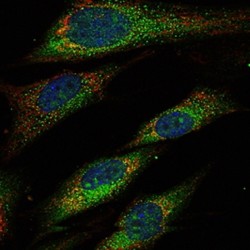 Key fertility enzyme identified
Key fertility enzyme identified
Scientists have discovered an enzyme that acts as a ‘fertility switch’. The study, published in Nature Medicine, has found high levels of the enzyme in women who can’t conceive, while low levels predispose to recurrent pregnancy-loss. The multi-centre study involved CSC’s Embryonic Stem Cell Facility and Imperial College London’s Institute of Reproductive and Developmental Biology, among other European institutes.
With implications for both the treatment of infertility and recurrent miscarriage, the findings could also lead to new contraceptives. Around one in six women have difficulty getting pregnant. One in a hundred suffer recurrent miscarriage.
Women being treated at Imperial College Healthcare NHS Trust – either for unexplained infertility or for recurrent miscarriage – donated tissue samples from their womb lining (endometrium) to the research project. Previous studies had linked unexplained infertility to increased levels of an enzyme called Serum & Glucocorticoid Kinase 1 (SGK1). So the team compared samples taken in the middle of the menstrual cycle from women with proven fertility, and women with unexplained infertility or recurrent miscarriage. SGK1 levels were higher in the group with unexplained infertility, but lower in the group prone to miscarriage, even when compared to women with proven fertility.
This enzyme plays a crucial role in transporting ions and is known to be important for cell survival. The scientists wanted to test whether elevated SGK1 might interfere with the embryo being implanted in the womb. In humans, there is a limited window (2–4 days) after ovulation when implantation can take place, during which the endometrium has an optimal uterine environment to be receptive to an embryo.
The team found that levels of SGK1 decreased in mouse womb lining during the fertile window. When they injected extra copies of the SGK1 gene into the womb lining, the mice couldn’t get pregnant. So low levels of the enzyme seem to make the uterus receptive to embryos. “Uterine weight was also reduced significantly in SGK1-injected mice,” explains Professor Jan Brosens (now at Warwick Medical School), “with a smaller glandular area, and less space between epithelial cells. The enzyme also, directly attenuated the activity of several uterine receptivity genes, rendering the uteri unreceptive”.
So how can we explain low SGK1 in women who suffered recurrent miscarriage?
Madhuri Salker (Institute of Reproductive and Developmental Biology), first author of the paper, elucidates: “After an embryo is implanted, the lining of the uterus develops into a specialized structure called the decidua that leads to the placenta forming – abnormalities in the decidua can lead to pregnancy complications, such as miscarriage. We found that low SKG1 didn’t prevent implantation in mice, though litters were smaller and there was some bleeding, making miscarriage more likely.”
A careful balance of SGK1 is required throughout pregnancy. Levels must decrease for during the implantation window, though SGK1 needs to increase afterwards to ensure placental formation: “Depending on the cellular compartment, deregulated SGK1 activity in cycling endometrium interferes with embryo implantation, leading to infertility. It can predispose to pregnancy complications by rendering the feto-maternal interface vulnerable to oxidative damage,” concludes Madhuri.
Together, these findings provide fundamental insights into the process of embryo implantation and describe a novel paradigm of pregnancy failure with potentially far-reaching clinical implications.
SJ
Published in Nature Medicine
Salker, M. S., Christian, M., Steel, J. H., Nautiyal, J., Lavery, S., Trew, G., Webster, Z., Al-Sabbagh, M., Puchchakayala, G., Foller, M., Landles, C., Sharkey, A. M., Quenby, S., Aplin, J. D., Regan, L., Lang, F., Brosens, J. J. (2011). Deregulation of the serum- and glucocorticoid-inducible kinase SGK1 in the endometrium causes reproductive failure. Nature Medicine 17, 1509-1513.
